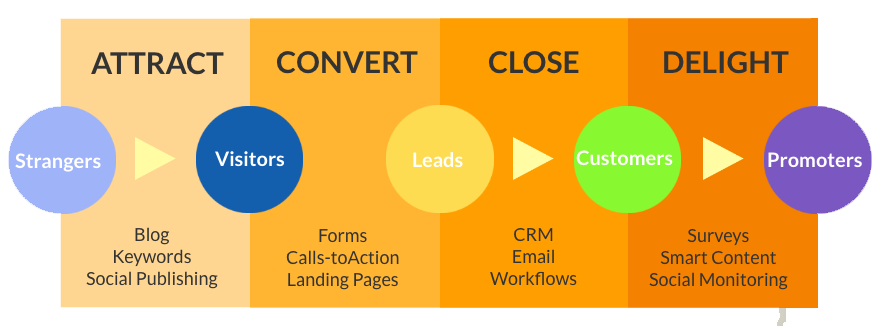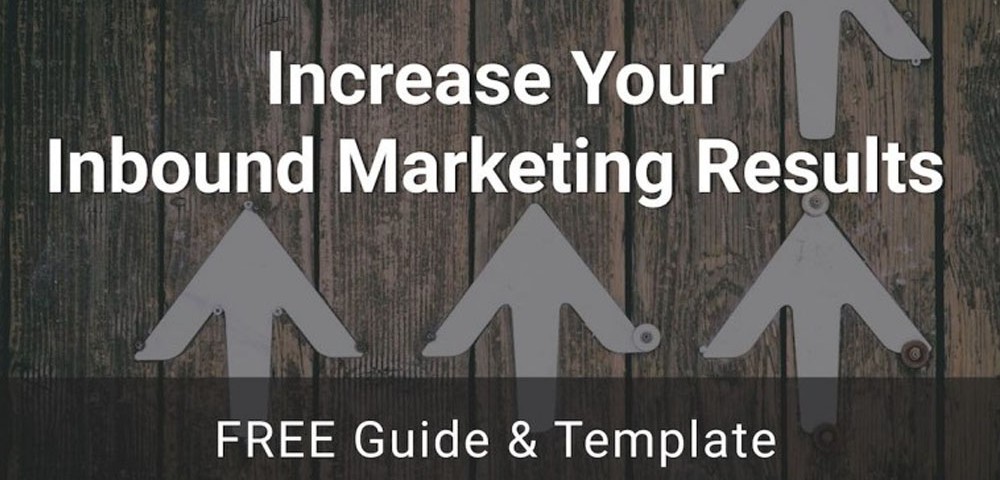Increase Your Inbound Marketing Results – 7 Easy Steps

Buyer Personas: How to Improve Your Campaigns
September 16, 2016
Using Buyer Personas to Create Successful Inbound Marketing Campaigns
September 27, 2016What is Inbound Marketing?
Inbound marketing, is the implementation of strategic processes that drive potential customers to your website with the goal of converting visitors to leads, leads to customers and customers into brand advocates. Every system is benchmarked and measured. Every decision and every activity is driven by data.
This is the first article in our series, “Increase Your Inbound Marketing Results – 7 Easy Steps.” If you will follow along with us, download the tools we provide in each article and complete the steps recommended in each article, you’ll be ready to launch a powerful campaign that will outperform your typical results. If this is your first campaign, you’ll be ready to launch a campaign that will create new customers within the next 60 days or less.
In this article, we outline the first step to creating and increasing your Inbound Marketing Campaign results. This is a down and dirty, step-by-step, inbound marketing crash course. It will jumpstart your marketing campaign, increase your website traffic, increase your leads and help you close more customers.
Let’s get started!
Why is Inbound Marketing Better than Traditional Marketing?
The world of marketing is changing at a rapid pace. The way buyers want to buy has been turned upside down. The old sales strategy doesn’t cut it any more. No one responds to it. Everybody hates it. The Internet made it easy to do your research prior to purchasing. No more pushy sales people trying to sell you and close you.
Content abounds. For every question you have – there’s an answer online. You can find answers to nearly every need, pain, symptom or requirement. You can buy nearly any solution or widget on line. If you prefer to buy in person, at the click of a button you can easily find out who has it in stock right now. As a result of this convenience, a trend began. Then an expectation evolved. Before we realized it, the entire sales process had changed.
We adapted quickly to searching the Internet for every question we have at every phase of our buying journey. Regardless of the industry you are in, your buyer’s journey follows these three phases:
- Awareness Phase – The buyer has a symptom, a pain or a need and they aren’t quite certain what the problem or the solution is, so they begin searching for answers online.
- Consideration Phase – The buyer has identified the problem and put a name to it. They are now looking online for options to resolve it.
- Decision Phase – They buyer has narrowed the vendors down, is comparing value, features and pricing and is making a decision about who they will buy from. They are looking for prices, feature comparisons, and seller integrity.

Successful businesses have learned that they must produce content that speaks to their specific buyer at each phase of the journey or buying process. Doing this well creates familiarity, brand trust and inspires loyalty. Having systems in place to nurture your buyer through the buyer’s journey will support you in growing your online and offline sales.
This is how people buy. It’s not mysterious, but it is time consuming for the vendor. And, it’s not a choice if you want to grow your business. This is inbound marketing. Studies show that more than 93% of local buyers conduct their research online, before contacting the local vendor.

How to Get Your Business Found in Google
We are bombarded with ads, emails and promotional messaging. It’s everywhere. In fact, most of us have learned to block it so intuitively that we don’t even realize we are doing it.
Online reports suggest that our population skips somewhere between 87% – 90% percent of their TV ads and 91% continuously unsubscribe from emails. We despise spam, cold calls, aggressive pop-ups, and all other intrusive marketing and sales practices. To put it simply: If you want to attract more targeted traffic, you have to offer people something they love and cherish.
If your content doesn’t show up on page one, its chances of receiving visitor click-throughs diminish significantly. To get your content to rank on page one of Google, at a minimum, you’ll have to do the following:
- Do keyword analysis and be sure to use the keyword phrases that your buyer will be searching for
- Include those keywords, phrases and long-tail terms within your article
- Write really, really good content
- Following best practice on-page optimization protocol, optimize the webpage that hosts your new content (as well as your entire website)
- Post your content on the social media channels your buyer persona frequents
- Post in forums your buyer persona frequents
- Boost your best posts on social media
- Use PPC / Ads to promote your content, offer or blog post
I’ve written several articles for do-it-yourselfers on how to increase the visibility of your content.
- On-page: 2015 Highest Ranking Web Pages Leverage These Two Factors
- Rank Number 1 in Google – 3 Steps and Resources You Can Do Today
- Google’s Top SEO Ranking Factors: What Matters Most
- Seven Hacks to Improve Search Engine Rankings and Traffic to Your Blog
- SEO: A Beginners Guide
There are many more tactics you can do to increase visibility and page rankings; however, I highly recommend you get support from an SEO and a content marketing expert so that your time, resources and results are optimized.
Content is King
You’ve heard it said, “Content is king.” We crave information. We expect to find an answer to every question online and we devour that information many formats.
Are you ready to attract more buyers to your website?
You’ll need to have:
- High-quality, buyer-persona– and buyer-phase-relevant content (I provide complimentary, detailed How-to-Guides on those pages, too)
- It must be attractive, easy to consume, easy to read
- Content that moves the needle on the buyer’s understanding of their problem, their solution options and information that helps them understand how to achieve the highest levels of success as a result of implementing your solution
- A process that makes it easy for your customer to buy and easy to get started
Content that Converts
At its very core, inbound marketing is the art of creating great content that meets each of your unique buyer persona’s personal needs. It must meet them right where they are, answering the questions they have as they move through the buyer’s journey. You’ll have to employ mechanisms to nurture your buyer through the marketing funnel, ultimately converting them to a customer. You’ll also need to use the proper keywords and phrases so your content ranks well in the search engines.
Over the next few weeks, we’ll be posting articles that outline the seven easy steps that will increase your inbound marketing results. We’ll provide all of the assets, templates, resources and guides you’ll need to achieve impressive results. In addition, we’ll give you step-by-step instructions to launch your first campaign.
By the end of this series, you’ll be ready to launch a campaign destined for greater success. If you have never launched a campaign before, not only will you be ready to launch your first campaign, you’ll be able to avoid the common pitfalls that sabotage success.
Inbound Marketing – The First Step
Develop a Powerfully Accurate Buyer Persona
The first step in developing an inbound marketing campaign is to understand your buyers. Within your entire target market, you likely have several unique buyer personas. Your buyer persona, sometimes referred to as a customer persona, directly influences every element within your inbound marketing campaign.
We’ve written an exhaustive “How to” article on creating detailed buyer personas and we’ve provided a detailed, step-by-step Buyer Persona guide and template for you here. I recommend using this article as your “How-to” guide for creating your buyer persona.
Every offer you create, every article you write and every promotional post you make (I hear the Police) should speak directly and personally to the unique needs of a specific buyer persona. No more shotgun approach to publishing content. It does not work.
Traditional websites and landing pages contain content that is written in general terms and is mostly about your product. Your website will never attract your buyers if the content on your pages is general and if it doesn’t address your buyer’s personal needs. Rather than trying to address the needs of the buyer at every phase of their journey on one landing page, you’ll want to develop individual landing page content and offers that speak to each phase of the buyer’s journey.
I hear your thoughts… the answer is “Yes.”
So, yes, if you need to target 5 distinct buyer personas for one product, you’ll need 5 different kinds of pages or series of pages for each phase of the buyers journey, each speaking to a single buyer persona.
And yes… that’s a lot of content.
Welcome to the new world of buying. Welcome to the new world of marketing.
Stick with us on this inbound marketing campaign creation course. Download our Ultimate Guide to Creating a Detailed Buyer Persona and get your first buyer persona created. Our next article will discuss Step Two – Conducting the Content Audit.
If you need any help throughout the process feel free to reach out to me via Facebook, Twitter, Email, or even the old fashion way – give me a call.





